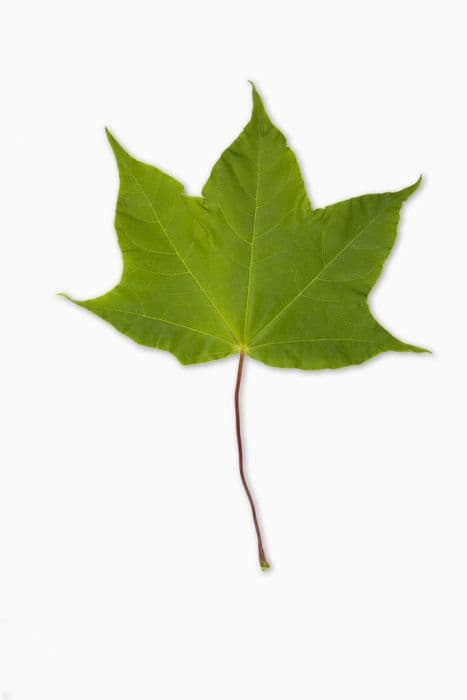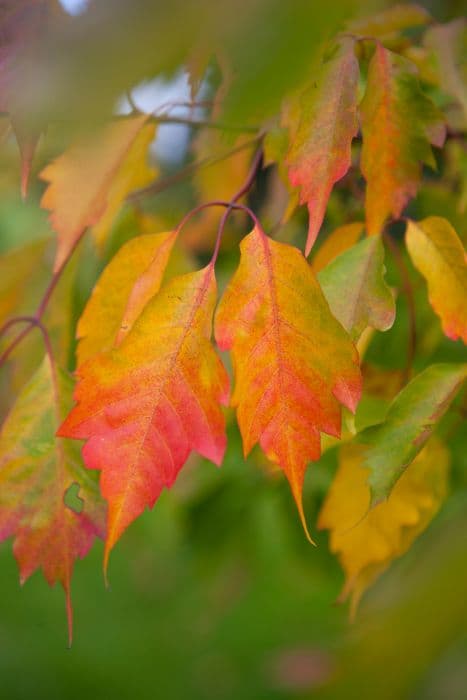Norway Maple Acer platanoides Princeton Gold = 'Prigo' (PBR)
![Norway maple [Princeton Gold]](/_next/image?url=https%3A%2F%2Fplants-admin.emdemapps.com%2Fimages%2Fplants%2F%2Fimages%2F604b5dd5c27f0.png&w=3840&q=75)
ABOUT
The Princeton Gold Maple, known botanically as Acer platanoides Princeton Gold = 'Prigo', is distinguished by its vivid display of foliage which emerges a lustrous golden yellow in the spring. The color provides a striking contrast, as it is quite bright and eye-catching when the leaves first unfold. As the season progresses, the leaves mature to a golden green, offering a warm and consistent color palette throughout its canopy. The leaves are shaped similarly to those of the classic maple, with a characteristic palmate form that splits into multiple lobes, each with well-defined edges that create an intricate pattern. The texture of the leaves is smooth, and they seem to glow when they catch the sunlight, giving the canopy an almost luminous quality on bright days. Flowers and fruits are part of this maple's life cycle, but they are not the main attraction. The flowers are subtle, borne in small clusters, and they precede the leaf emergence in the spring. Small samaras, which are winged seeds, follow the flowering period and whirl down from the tree when mature, sometimes creating a fleeting, helicopter-like display. The bark of the Princeton Gold Maple adds to its overall appearance, usually gray-brown and becoming lightly furrowed as the tree matures, providing an elegant texture and backdrop for the striking leaves. The branch structure can be dense and contributes to the plant's overall rounded and lush appearance. Overall, the Princeton Gold Maple is primarily celebrated for its radiant foliage, making it a standout specimen in any landscape where the gold and green hues can be fully appreciated without being overshadowed by larger elements within the setting.
About this plant
 Names
NamesSynonyms
Norway Maple, Princeton Gold Maple.
Common names
Acer platanoides 'Princeton Gold', Acer platanoides Princeton Gold 'Prigo' (PBR).
 Toxicity
ToxicityTo humans
Norway maple (Acer platanoides Princeton Gold = 'Prigo' (PBR)) is generally not considered toxic to humans. There are no well-documented cases of poisoning from the Norway maple, and it is not known for containing any significant toxins that would cause symptoms of poisoning if ingested. However, as with many plants, individual sensitivities can vary, and it is always prudent to avoid ingesting plant material that is not commonly used as food. If accidental ingestion occurs, and the individual experiences any adverse reactions, it is recommended to seek medical advice.
To pets
Norway maple (Acer platanoides Princeton Gold = 'Prigo' (PBR)) is also not typically considered toxic to pets. Most animals will not suffer from poisoning if they ingest parts of this tree. However, pet owners should be cautious as the ingestion of non-food plant material could potentially cause stomach upset or an intestinal blockage, especially if large quantities are consumed. Owners should monitor their pets for signs of discomfort after ingestion, and if any symptoms occur, such as vomiting or diarrhea, consult a veterinarian.
 Characteristics
CharacteristicsLife cycle
Perennials
Foliage type
Deciduous
Color of leaves
Yellow-green
Flower color
Yellow-green
Height
35 feet (10.67 meters)
Spread
30 feet (9.14 meters)
Plant type
Tree
Hardiness zones
4
Native area
Europe
Benefits
 General Benefits
General Benefits- Vibrant Foliage: The Princeton Gold Maple is known for its striking golden-yellow foliage that adds a bright splash of color to any landscape throughout the growing season.
- Shade Provider: With its broad canopy, it can offer significant shade, making it useful for cooling homes and creating comfortable outdoor sitting areas.
- Adaptable Growth: This tree is adaptable to a variety of soil conditions, which makes it a viable option for many different landscape scenarios.
- Urban Tolerance: It has a good tolerance to urban pollution, which means it can thrive in city environments where other trees might struggle.
- Seasonal Interest: Beyond its spring and summer appeal, the Princeton Gold Maple provides interest in fall with leaves that may turn greenish-bronze before they drop.
- Wildlife Habitat: It can serve as a habitat and food source for various species of birds and insects, thus supporting local biodiversity.
- Low Maintenance: The tree is relatively low maintenance, with no serious pest or disease problems, making it a convenient choice for gardeners and landscapers.
- Fast Growth: It has a relatively fast growth rate, which allows for a quicker establishment and a sooner realization of the tree's aesthetic and practical benefits.
 Medical Properties
Medical PropertiesThis plant is not used for medical purposes.
 Air-purifying Qualities
Air-purifying QualitiesThis plant is not specifically known for air purifying qualities.
 Other Uses
Other Uses- Photography and Art Subjects: The Princeton Gold Maple, with its vibrant gold-colored leaves, serves as a stunning subject for photographers and artists, especially in autumn.
- Educational Resource: This tree can be used in schools and educational programs to teach students about plant biology, hybridization, and the importance of biodiversity.
- Furniture Material: Wood from the Princeton Gold Maple can be crafted into furniture, although it's not as commonly used as wood from other maple species.
- Shade Provider for Recreation: Its broad canopy makes it an excellent tree for providing shade in playgrounds, parks, and backyards.
- Natural Sound Barrier: When planted in rows, Princeton Gold Maples can act as a natural sound barrier, reducing noise pollution in urban areas.
- Culinary Decorations: While not commonly known for its culinary uses, the tree's leaves can be used as decoration for plating in high-end restaurants during the autumn season.
- Leaf Castings: Its unique leaves can be used to make decorative castings for artistic purposes, such as wall hangings or ornaments.
- Culture and Tradition: In some cultures, the Princeton Gold Maple may be integrated into traditional ceremonies or used as a symbol during certain festivals.
- Soil Improvement: The tree, when planted in appropriate conditions, can help in soil improvement by preventing erosion with its root system.
- Biomimicry Inspiration: The tree's efficient way of using sunlight for energy can inspire designs in solar energy technology and architecture.
Interesting Facts
 Feng Shui
Feng ShuiThe Norway Maple is not used in Feng Shui practice.
 Zodiac Sign Compitability
Zodiac Sign CompitabilityThe Norway Maple is not used in astrology practice.
 Plant Symbolism
Plant Symbolism- Growth and Expansion: As a maple tree, the Princeton Gold Maple is symbolic of growth and expansion, representing personal growth or the expansion of one's own horizons.
- Strength and Endurance: Maple trees are known for their hardy nature and their ability to withstand various climates, symbolizing strength and the ability to endure challenges.
- Balance: The Princeton Gold's balanced and symmetrical canopy can symbolize the importance of balance in life.
- Beauty: The striking golden-yellow foliage of the Princeton Gold Maple is associated with beauty and the appreciation of aesthetic pleasures.
- Wisdom: In some cultures, the maple is seen as a tree of wisdom and learning, possibly due to the long lifespan of maples and their impressive stature.
 Water
WaterThe Norway Maple 'Princeton Gold' typically prefers consistently moist soil without being waterlogged, so watering should be done deeply and thoroughly once or twice a week depending on weather conditions, with more frequent watering required during hot, dry periods. Generally, young trees benefit from about 15-20 gallons of water per week, while established trees might need less frequent watering but with a greater volume of water to ensure that moisture reaches the deep roots. Adjust watering based on rainfall and soil drainage, and use a slow-release method such as a drip irrigation system or a soaker hose to allow water to penetrate deeply into the soil.
 Light
LightNorway Maple 'Princeton Gold' thrives in full sun to partial shade, preferring at least four to six hours of direct sunlight per day. A location that receives morning sunlight with some afternoon shade is ideal, especially in regions where summer temperatures get very high. Avoid deep shade locations, as this can reduce the tree's vigor and the vibrancy of its golden foliage.
 Temperature
TemperatureThe 'Princeton Gold' Norway Maple is hardy and can tolerate a wide range of temperatures. It performs best in areas with a temperature range from about -30°F to 90°F. This maple can endure cold winters and has a USDA hardiness zone range of 4 through 7, indicating its adaptability to various climate conditions, with ideal growth temperatures spanning from 60°F to 75°F.
 Pruning
PruningPrune the 'Princeton Gold' Norway Maple to remove dead, damaged, or diseased branches and to maintain its shape and size. The best time for pruning is during the tree's dormant period in late winter to early spring, before sap flow begins. Pruning should be done as needed, usually every three to five years for mature trees, ensuring cuts are clean and made just outside the branch collar for proper healing.
 Cleaning
CleaningAs needed
 Soil
SoilThe Norway Maple 'Princeton Gold' prefers a well-draining soil mix, rich in organic matter. A blend of loamy soil, peat, and sand works well to balance drainage and nutrient retention. The ideal pH for this tree is between 5.5 and 7.5. Regularly adding organic mulch can also help maintain soil health.
 Repotting
RepottingThe Norway Maple 'Princeton Gold' typically does not require regular repotting as it is a large landscape tree. It is planted in a permanent location where it has ample space to grow, and thus repotting is not applicable for this tree.
 Humidity & Misting
Humidity & MistingThe Norway Maple 'Princeton Gold' is adaptable to outdoor humidity levels and does not require specific humidity conditions. Being a hardy landscape tree, it can tolerate the humidity ranges found in its hardiness zone.
 Suitable locations
Suitable locationsIndoor
Norway Maple 'Princeton Gold' isn't suitable for indoor growth due to its size.
Outdoor
Plant in deep, fertile soil with full sun to partial shade.
Hardiness zone
4-7 USDA
 Life cycle
Life cycleAcer platanoides Princeton Gold, commonly known as the Princeton Gold Maple, begins its lifecycle with seed germination, typically in the spring when soil temperatures rise. The germinated seedlings grow into juvenile plants with a simple structure, eventually developing into saplings with a formed root system and foliage. Over several years, the saplings mature into adult trees, characterized by a robust trunk, branching canopy, and bright golden-yellow leaves. Each spring, the mature Princeton Gold Maple produces small, inconspicuous flowers which, after pollination, develop into samaras, or 'helicopter seeds.' These seeds are then dispersed by the wind in late spring or early summer, propagating the cycle. The tree, in its climax stage, can maintain its mature form for decades, enduring through seasonal changes and environmental challenges, until it reaches senescence and dies, completing its lifecycle.
 Propogation
PropogationPropogation time
Late winter
The Norway Maple 'Princeton Gold' is typically propagated by grafting, which is the most popular method for this cultivar. Grafting should be conducted during the dormancy period, generally in late winter or early spring. To graft, a piece of stem with dormant buds, called a scion, is taken from a Norway Maple 'Princeton Gold'. This scion is then inserted into a cut made in the rootstock, which is usually a seedling or a younger plant of a closely related species or variety. The union is secured with grafting tape or a similar material which keeps the graft firmly in place while the tissues heal and fuse together, a process that can take several weeks to months. Grafting ensures that the new plant will display the exact characteristics of the 'Princeton Gold', as seeds may not result in true-to-type offspring due to cross-pollination with other maple varieties.








